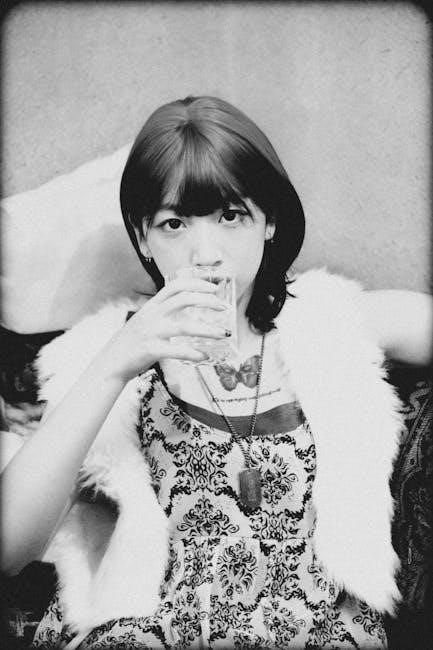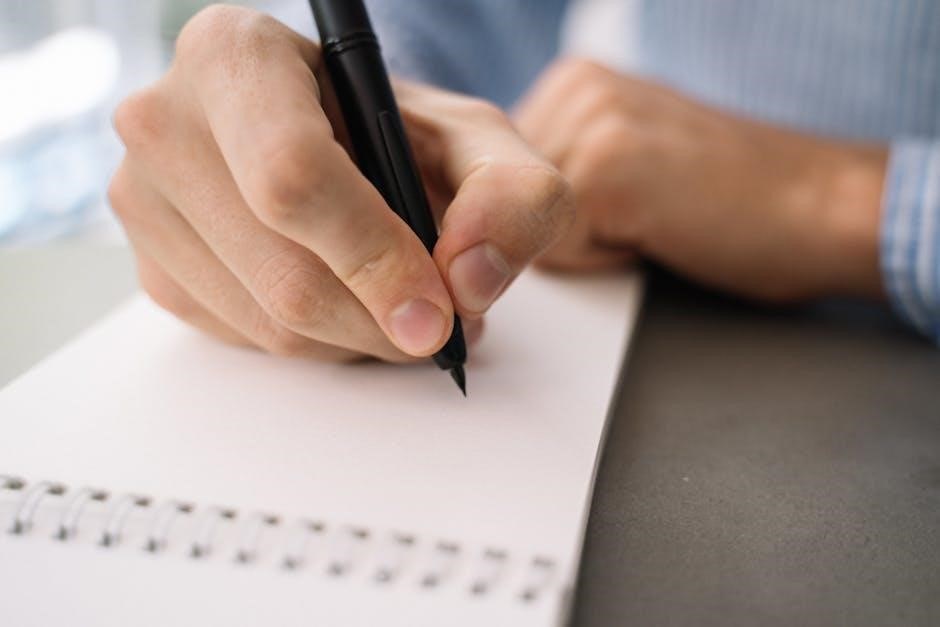
pdf tattoo
Pdf tattoos represent a fusion of traditional art and digital innovation, offering precise designs and cultural expression through versatile tools and augmented reality enhancements.
What is a PDF Tattoo?
A PDF tattoo refers to a digital tattoo design template stored in Portable Document Format (PDF). These files contain detailed, high-resolution tattoo designs, often organized into flash sheets or stencils. PDF tattoos are widely used by tattoo artists and enthusiasts for their versatility, scalability, and clarity. They can include various styles, such as minimalist patterns, Celtic knots, or intricate Chinese art. The format allows for easy sharing, printing, and editing using tools like Drawboard PDF or PDF-XChange Viewer. PDF tattoos are particularly popular for pre-session planning, enabling clients and artists to collaborate effectively. Their digital nature also supports customization, making them a modern tool in the tattoo art industry.
Evolution of Tattoo Art in Digital Formats
The evolution of tattoo art in digital formats has transformed the industry, blending traditional techniques with modern technology. PDF tattoos emerge as a key innovation, offering high-resolution, scalable designs that maintain clarity across devices. Digital tools like Drawboard PDF and PDF-XChange Viewer enable artists to create and edit intricate designs with precision. The rise of augmented reality (AR) further enhances this evolution, allowing clients to visualize tattoos on their bodies virtually. This shift from physical flash sheets to digital formats has made tattoo art more accessible, collaborative, and customizable. The integration of PDF and AR technologies signifies a new era in tattoo culture, merging tradition with cutting-edge innovation for limitless creative expression.

Importance of PDF in Tattoo Design
The Portable Document Format (PDF) plays a crucial role in tattoo design due to its universal compatibility and high-quality rendering. PDF files maintain their formatting and resolution across all devices, ensuring that tattoo designs appear consistent for both artists and clients. This format is particularly advantageous for intricate designs, as it preserves fine details without loss of clarity. Additionally, PDFs can be easily shared and edited, facilitating collaboration between artists and clients. The ability to add layers in PDFs allows for better organization of complex designs. Furthermore, PDFs support password protection, safeguarding custom designs from unauthorized use. Overall, PDFs provide a reliable and versatile medium for creating, sharing, and refining tattoo art, making them indispensable in modern tattoo design workflows.

Cultural and Historical Significance of Tattoos
Tattoos hold deep cultural and historical significance, serving as expressions of identity, spirituality, and art across various civilizations for thousands of years, with PDFs aiding in preserving these historical designs.

Traditional Tattoo Art and Its Digital Transformation
Traditional tattoo art, deeply rooted in cultural heritage, has undergone a significant digital transformation with the advent of PDF technology. Artists now use PDFs to create and share intricate designs, preserving traditional styles while enhancing accessibility. This format allows for precise scaling and clarity, ensuring designs remain consistent across different mediums. The digital shift has also enabled global collaboration, bridging the gap between traditional techniques and modern tools. PDFs have become essential for creating stencils, making the tattooing process more efficient. This fusion of tradition and technology ensures that timeless designs endure, reaching a broader audience while maintaining their cultural essence and artistic integrity.
Cultural Phenomenon of Tattoos Across the Globe
Tattoos have evolved into a global cultural phenomenon, with diverse designs reflecting regional identities and artistic expression. From Japanese tebori to Polynesian tribal patterns, tattoos symbolize cultural heritage and personal identity. The rise of digital tools, including PDFs, has facilitated the sharing and adaptation of these designs worldwide. PDF tattoos enable artists to maintain design integrity while catering to global clientele. This digital accessibility has bridged cultural gaps, allowing individuals to embrace tattoos as a universal language of art and self-expression. The fusion of traditional techniques with modern technology continues to drive tattoo culture’s global appeal, making it a testament to human creativity and cultural exchange.

Historical Roots and Modern Interpretations
The origins of tattoos date back thousands of years, with evidence of ancient civilizations like the Egyptians, Greeks, and Polynesians practicing tattooing for spiritual, ceremonial, and decorative purposes. These traditional designs often carried deep symbolic meanings, reflecting cultural beliefs and societal status. Modern tattoo art has reinterpreted these historical roots, blending traditional techniques with contemporary styles. The advent of PDF tattoos has further transformed this art form, allowing for precise replication and customization of designs. This fusion of historical significance with digital innovation ensures that tattoos remain a vibrant and evolving form of self-expression, bridging the gap between ancient traditions and modern creativity.

Design Inspiration for PDF Tattoos
Design inspiration for PDF tattoos stems from diverse sources, including nature, art movements, cultural symbols, and personal experiences. PDFs enable scalable, customizable designs, blending traditional and modern aesthetics seamlessly. Digital tools empower artists to craft intricate, unique designs, fostering creativity and precision in tattoo art.
Traditional Tattoo Designs
Traditional tattoo designs are timeless and deeply rooted in cultural heritage. These designs often feature bold lines, vibrant colors, and symbolic imagery, such as anchors, roses, and skulls. PDF formats allow artists to preserve the intricate details of these classic designs, ensuring clarity and scalability. Many traditional tattoos draw inspiration from historical art forms, like Japanese tebori or Polynesian tribal patterns. The use of PDFs makes it easier for artists to share and adapt these designs while maintaining their authenticity. This digital approach bridges the gap between ancient traditions and modern tattoo practices, keeping traditional tattoo art accessible and relevant for contemporary enthusiasts.
Modern Tattoo Trends
Modern tattoo trends emphasize personalization and artistic innovation, with PDFs playing a crucial role in their creation and sharing. Popular styles include minimalist designs, small tattoos, and geometric patterns, which PDFs render with precision. Custom designs, often incorporating meaningful symbols, are easily editable in PDF formats. The use of PDFs ensures scalability and clarity, essential for intricate details in fine line art. Additionally, PDFs facilitate collaboration between artists and clients, allowing for real-time adjustments. This digital approach supports the evolving nature of modern tattoo trends, making complex designs more accessible and adaptable. As a result, PDFs are indispensable in contemporary tattoo art, bridging creativity with practicality.
Custom Tattoo Designs in PDF Format
Custom tattoo designs in PDF format allow for personalized and intricate artwork tailored to individual preferences. PDFs provide high-resolution visuals, ensuring clarity and precision in detailed designs. This format is ideal for creating unique patterns, symbols, and lettering that reflect personal stories or cultural significance. Artists can easily edit and refine designs in PDF, enabling real-time collaboration with clients. The ability to scale designs without losing quality makes PDFs versatile for various body placements. Additionally, PDFs streamline the tattooing process, as they serve as clear stencils for artists, ensuring accurate ink placement. This format has revolutionized custom tattoo design, offering both creativity and practicality for artists and clients alike.
Popular Tattoo Design Categories
Popular tattoo categories include Celtic, Tribal, Japanese, and Minimalist designs. PDF formats offer precise templates for these styles, ensuring clarity and detail for artists and clients.
Celtic Tattoo Designs
Celtic tattoo designs are renowned for their intricate knotwork, spirals, and symbolic patterns. These designs often represent spirituality, heritage, and connection to ancient Celtic culture. PDF tattoos allow artists to preserve the precision and detail of these complex motifs, ensuring clarity for both creation and application. The digital format enables easy customization, letting clients personalize symbols like the Celtic cross or triskele. PDFs also maintain scalability without losing quality, making them ideal for large or small designs. This blend of tradition and modern technology keeps Celtic tattoos timeless and accessible, appealing to those seeking meaningful, visually striking body art. Their popularity endures due to their deep historical and aesthetic significance.
Dragon and Butterfly Tattoos
Dragon and butterfly tattoos are popular choices, symbolizing opposing yet complementary energies. Dragons often represent strength, power, and wisdom, while butterflies embody transformation, beauty, and freedom. PDF tattoos allow artists to create intricate, scalable designs that capture these symbols’ essence. The digital format ensures precise details, from the dragon’s scales to the butterfly’s wings, remain crisp at any size. Clients can easily review and adjust designs before tattooing, ensuring satisfaction. PDFs also facilitate color accuracy, making vibrant dragon and butterfly designs stand out. This format bridges artistic vision and client expectations, fostering collaboration and stunning results in tattoo art.
Chinese Tattoo Art
Chinese tattoo art is deeply rooted in centuries of cultural symbolism, often featuring iconic motifs like dragons, phoenixes, and bamboo. PDF tattoos have become a popular medium for preserving and sharing these intricate designs, ensuring clarity and scalability. The format allows artists to maintain the delicate balance of lines and colors, essential for capturing the essence of Chinese art. Clients can easily review and adjust designs before tattooing, fostering collaboration. PDFs also enable the fusion of traditional imagery with modern aesthetics, creating unique and personalized pieces. This digital approach respects the heritage of Chinese tattoo art while embracing contemporary innovation, making it accessible to a global audience.

Tools and Software for PDF Tattoo Design
Professional tools like Adobe Illustrator and Photoshop enable artists to craft detailed PDF tattoo designs with precision. These software options support scalable vector graphics, ensuring designs remain crisp at any size, which is essential for tattooing. They also allow for easy editing and collaboration between artists and clients, streamlining the creative process. Additionally, specialized PDF editors like Drawboard PDF and PDF-XChange Viewer provide intuitive interfaces for refining and annotating designs, making them ideal for tattoo art. These tools collectively enhance the quality and accessibility of PDF tattoo designs, catering to both artists and clients worldwide.
Drawboard PDF for Tattoo Design
Drawboard PDF is a powerful tool for creating and editing tattoo designs in PDF format. It offers intuitive markup and annotation features, allowing artists to refine designs with precision. The software supports layers, making it easy to separate elements like line work, shading, and colors. Tattoo artists can collaborate with clients by adding notes and annotations directly within the PDF; The pen and touch-friendly interface enhances creativity, while the ability to export high-resolution images ensures designs are print-ready. Drawboard PDF is compatible with both desktop and mobile devices, providing flexibility for artists on the go. Its user-friendly interface and robust features make it an excellent choice for tattoo design workflows.
PDF-XChange Viewer for Tattoo Art
PDF-XChange Viewer is a lightweight yet versatile tool for viewing and editing PDF files, making it ideal for tattoo art. It features annotation tools, allowing artists to add notes, highlight areas, and mark revisions directly on the design. The software supports layers, enabling precise adjustments to tattoo designs. Its measurement tools help ensure scalability and accuracy, which is crucial for tattoo placements. Artists can also convert images to PDF and edit them seamlessly. The viewer’s free version offers essential features, while the pro version provides advanced editing capabilities. Its compatibility with multiple platforms makes it a flexible choice for tattoo artists to review and refine their designs efficiently before transferring them to clients.
Free and Paid PDF Editors for Tattoo Designs
When working with PDF tattoo designs, selecting the right editor is essential for precision and creativity. Free options like PDF-XChange Viewer and Inkscape offer basic editing tools, such as annotation and layer support, ideal for minor adjustments. GIMP is another free alternative, providing robust image editing capabilities. For more advanced features, paid editors like Adobe Acrobat and CorelDRAW are preferred, offering tools like vector editing and high-resolution output. These paid tools often include features like batch processing and professional-grade design options. Choosing the right editor depends on the complexity of the tattoo design and the artist’s specific needs, ensuring the final PDF is detailed and ready for application.
Creating and Editing PDF Tattoos
Designing and modifying PDF tattoos requires precision and artistic skill. Artists use software like Adobe Illustrator or Procreate to create high-resolution, scalable designs. Editing involves refining lines, colors, and details to ensure clarity and accuracy for tattoo application. The process balances creativity with technical demands, ensuring the final PDF is print-ready and suitable for stencil creation.
Step-by-Step Guide to Creating Tattoo PDFs

Creating tattoo PDFs involves a structured process to ensure high-quality, printable designs. Begin by sketching your concept on paper or digitally using tools like Adobe Illustrator or Procreate. Once satisfied with the design, refine the lines, ensuring clarity and boldness for stencil purposes. Use high-resolution settings (300 DPI) to maintain detail. Save the design as a PDF, selecting options like “Press Quality” for optimal results. Include multiple sizes and orientations to accommodate different tattoo placements. Finally, review the PDF for accuracy and print a test copy to verify scalability and legibility. This method ensures professional-grade PDFs ready for tattoo artists to use as stencils.
Best Practices for Editing Tattoo Designs in PDF
When editing tattoo designs in PDF format, prioritize clarity and precision. Use vector graphics to ensure scalability without loss of quality. Work in layers to organize complex designs, making adjustments easier. Maintain high contrast between lines and details to aid visibility for tattoo artists. Test the design on various skin tones digitally to ensure universality. Avoid over-complexity, as intricate details may not translate well to skin. Use standard fonts and linework compatible with tattoo machines. Regularly save and export iterations to track progress. Ensure the PDF is password-protected to safeguard intellectual property. Finally, proofread for any errors before sharing with clients or artists, ensuring the design is tattoo-ready.
Converting Images to PDF for Tattoo Stencils
Converting images to PDF for tattoo stencils ensures high-quality, scalable designs. Start by using high-resolution images to maintain clarity. Use tools like Adobe Acrobat or online converters to create PDFs. Ensure the design is in black and white or grayscale for stencil compatibility. Remove unnecessary elements to focus on the tattoo outline. Adjust image dimensions to match the intended body area. Save the PDF in standard settings for universal accessibility. Test the PDF by printing it to verify accuracy. This process guarantees that the stencil is precise and ready for tattoo artists to work with, preserving the integrity of the original design.
Health and Safety Considerations
Proper hygiene and sterilization are crucial in tattooing to prevent infections. Allergic reactions to ink can occur. Ensure safe environments and follow health guidelines strictly.
Medical Complications Related to Tattoos
Tattoos can lead to medical complications, including allergic reactions to ink, skin infections, and bloodborne pathogen transmission. Allergic reactions may cause redness, itching, or swelling. Certain ink colors, like red or black, are more likely to trigger these responses. Infections, such as bacterial or fungal, can occur if equipment is not properly sterilized. In severe cases, conditions like granulomas or keloids may develop. Additionally, tattoos can interfere with certain medical procedures, such as MRI scans, due to ink reactions. Proper hygiene and sterilization practices are essential to minimize these risks. Ensuring safe tattooing practices is critical to prevent long-term health issues for individuals with PDF tattoo designs.
Post-Tattoo Care and Recovery
Proper post-tattoo care is essential for healing and maintaining the design’s quality. Immediately after tattooing, the skin is sensitive and requires gentle cleaning with soap and water. Applying ointments or creams recommended by professionals helps prevent infections and promotes healing. It’s crucial to avoid direct sunlight, swimming, and tight clothing during the recovery period. PDF guides often include detailed aftercare instructions, ensuring clients follow best practices. Keeping the tattoo moisturized prevents scabbing and fading. Full recovery typically takes 2-3 weeks, but proper care can reduce the risk of complications. PDF tattoo designs, when paired with clear aftercare instructions, ensure a smooth and safe healing process for individuals.
Role of PDF in Tattoo Aftercare Instructions
PDFs play a vital role in providing clear and concise tattoo aftercare instructions. Tattoo artists often create detailed PDF guides that include step-by-step care routines, ensuring clients can easily follow proper healing practices. These documents typically feature high-quality images and text, making complex instructions understandable. PDFs are easily shareable via email or messaging platforms, allowing clients to access them anytime. They also serve as a professional tool for artists to showcase their expertise. By including aftercare instructions in PDF format, artists ensure consistency and clarity, reducing the risk of misunderstandings. This digital approach enhances the overall tattoo aftercare experience, benefiting both artists and clients alike.

Augmented Reality and PDF Tattoos
Augmented reality (AR) is transforming tattoo design by enabling clients to virtually try on PDF tattoo designs. This innovative approach enhances customization and visualization, making the process more engaging and precise for both artists and clients;
AR Technology in Tattoo Design
AR technology is revolutionizing tattoo design by allowing artists and clients to preview designs in real-time. Using PDF tattoo files, AR enables precise placement and scaling, ensuring a perfect fit on the body. This technology also allows for 3D modeling, giving a lifelike preview of how the tattoo will look. Artists can make adjustments instantly, enhancing creativity and client satisfaction. AR tools are particularly useful for complex designs, as they provide a clear visual guide before any ink is applied. This innovation bridges the gap between digital and physical art, making the tattoo process more collaborative and accurate; It’s a game-changer for modern tattoo culture.
Virtual Tattoo Try-On Using PDF Designs
Virtual tattoo try-on using PDF designs is a groundbreaking application of AR technology, enabling clients to visualize tattoos on their skin before commitment. PDF files are uploaded to AR apps, allowing precise placement and realism. This tool reduces anxiety and ensures satisfaction, as clients can see how designs look on their body. Artists benefit by showcasing their work dynamically, facilitating better communication. The process is user-friendly, with adjustable sizing and positioning for a custom fit. This innovation enhances decision-making, making tattoo choices more confident and informed. Virtual try-ons are transforming the tattoo industry by bridging imagination and reality, offering a risk-free preview of permanent art.
Future of Tattoo Art with AR and PDF
The integration of AR and PDF technology promises to revolutionize tattoo art, offering unparalleled creativity and accessibility. PDF files will serve as the foundation for AR-powered tattoo designs, enabling artists and clients to collaborate more effectively. AR will allow real-time customization, making the design process more dynamic and interactive. This fusion of technologies will democratize tattoo art, enabling individuals to explore unique designs without commitment. The future holds potential for AR-driven tattoo studios, where PDF templates are brought to life digitally. This innovation will not only enhance artistic expression but also redefine how tattoos are conceptualized and created, paving the way for a more immersive and personalized tattoo culture.
Legal and Ethical Aspects
Tattoo designs in PDF format raise copyright and intellectual property concerns, requiring ethical considerations to ensure proper licensing and artist attribution, protecting both creators and clients legally.
Copyright Issues in Tattoo Designs
Copyright issues in tattoo designs, especially in PDF formats, often involve disputes over ownership and intellectual property rights. Tattoos are considered artistic works, but their reproducibility in digital formats complicates copyright claims. Artists may face challenges when their designs are shared or altered without permission. Additionally, tattoos inspired by copyrighted material, such as comic characters or movie logos, can lead to legal battles. Digital sharing of PDF tattoo designs increases the risk of unauthorized use, raising ethical concerns about proper attribution and compensation. To mitigate these issues, artists often use watermarks or licensing agreements, ensuring their work remains protected while allowing clients to use the designs legally.
Legal Considerations for Tattoo Artists
Tattoo artists must navigate various legal considerations to operate professionally. Licensing is essential, as most jurisdictions require health and safety certifications. Contracts with clients are crucial, outlining design ownership, payment terms, and liability. Employment status—whether as independent contractors or employees—affects taxes and benefits. Health regulations must be strictly followed to prevent infections. Client consent, especially for minors, is legally required. Insurance, like professional liability coverage, protects against accidents or disputes. Local laws may impose additional restrictions, such as zoning for tattoo parlors. Understanding these legal aspects ensures compliance and protects both artists and clients, fostering a safe and professional environment for creating and using PDF tattoo designs.
Ethical Use of PDF Tattoo Designs
The ethical use of PDF tattoo designs involves respecting intellectual property, ensuring originality, and maintaining transparency. Tattoo artists must verify the ownership of designs before sharing or using them in PDF formats. Proper attribution to the creator is essential to avoid copyright infringement. Clients should be informed about the source and legality of the designs. Additionally, cultural sensitivity is crucial when using traditional or symbolic designs to prevent appropriation. Ethical practices also include providing clear instructions for the use of PDF designs and ensuring they are accessible to clients with necessary accommodations. By adhering to these guidelines, artists promote trust and integrity in their work, fostering a responsible and respectful tattooing community.

The integration of PDFs in tattooing has revolutionized the industry by providing precise and sharable designs, enhancing collaboration between artists and clients while embracing technology for future advancements.
Future Trends in PDF Tattoo Art
The future of PDF tattoo art lies in enhanced customization, accessibility, and integration with emerging technologies like AR and AI. Artists will leverage AI tools to create intricate designs faster, while AR will allow clients to preview tattoos virtually. Sustainable practices may also rise, with eco-friendly PDF stencils reducing waste. The trend toward personalized, culture-inspired designs will grow, blending traditional techniques with modern digital innovation. As digital platforms evolve, PDFs will remain a cornerstone for sharing and preserving tattoo art globally, fostering collaboration between artists and clients. This fusion of technology and creativity promises to redefine tattoo culture, making it more dynamic and inclusive than ever.
Impact of Digital Tools on Tattoo Culture
Digital tools have revolutionized tattoo culture by democratizing access to high-quality designs and fostering global collaboration. PDFs enable artists to share precise stencils worldwide, ensuring consistency and innovation. Software like Adobe Illustrator and Procreate empowers creators to craft intricate designs with ease. Social media platforms amplify visibility, connecting artists with clients across continents. Virtual consultations and AR previews enhance client experiences, making tattoo decisions more informed. These advancements not only streamline the creative process but also blur cultural boundaries, creating a unified yet diverse tattoo community. The integration of technology has transformed tattoo art into a dynamic, inclusive, and ever-evolving global phenomenon, preserving traditions while embracing modernity.

Leave a Reply
You must be logged in to post a comment.